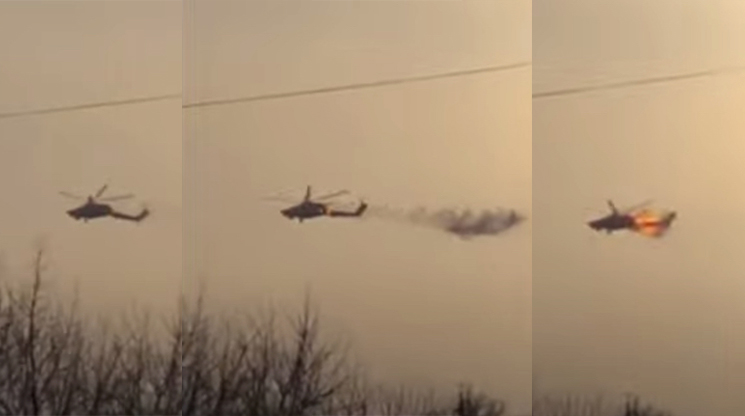Using ballistic rocket-launching tactic didn’t save this Russian gunship helicopter.
Just yesterday, we commented a video posted by the Russian MOD that proved that the Ka-52 Alligator helicopters are still lobbing unguided rockets at targets in Ukraine in the very same way we had observed a couple of weeks earlier, when the first clips of Russian Aerospace Forces Ka-52 and Mi-28 Havoc helicopters had started circulating online.
The tactic is the following: the helicopters fly at low level then pull up into steep climb, and launch the rockets at the top of the parabolic arc of their flightpath, sending them downrange, then they break hard left and escape fast at low altitude again to remain outside of man portable air defense systems’ kill zone.
As we explained, the above tactic, that turns the Russian helicopters into airborne MLRS (Multiple Launch Rocket System) launchers, extends the range of the rockets but is far from accurate, and could only be effectively employed against soft area targets that do not require accuracy or be used to put psychological pressure on the enemy. At the same time, this attack profile allows the gunships to attack their area targets from longer distance while remaining outside the range of the MANPADS
However, not even this tactic can save the attack helicopter from the Ukrainian air defense systems: US-made FIM-92 Stinger or Polish Piorun GROM Thunder MANPADS have been particularly lethal during the war against the Russian invaders. As the following video, that has emerged on Apr. 1, 2022, proves.
The footage shows the moment a Russian Mi-28 Havoc helicopter took a direct hit by a MANPADS missile that blew off its tail causing it to crash to the ground. Reportedly, the event occurred in the Luhansk Oblast.
Interestingly, at the beginning of the clip you can also see the gunship helicopter use the ballistic rocket-launching tactic, perform an evasion maneuver to egress the area at low level and be hit in the exhaust area by the missile that caused the tail boom to separate from the rest of the aircraft.
According to some reports, both pilot and gunner survived.
Downed Russian Mi-28 pic.twitter.com/nmDxTgxKsR
— OSINTtechnical (@Osinttechnical) April 1, 2022
Interestingly, The Times media outlet reported that the Mi-28 might have been shot down by a British Starstreak missile: A Ministry of Defence source believed that the video showed Starstreak in action over Ukraine. The source added that the anti-aircraft system had been deployed in the country for almost a week. Senior defence industry sources who examined the film also believe it to be the weapon.”
Read more: https://t.co/JEGZwcfMiR
— The Times (@thetimes) April 2, 2022
Starstreak is a British short-range man-portable air-defence system manufactured by Thales Air Defence, in Belfast. The Starstreak high-velocity missile system was supplied to Ukraine by Britain last month along with a further shipment of Next Generation Light Anti-tank Weapons (NLAWs).
“STARStreak’s highly unique design significantly differentiates it from other SHORAD missiles”, says Thales website. “Designed and developed from first principals to engage fast, evasive or heavily armoured pop-up targets, all in a short timeframe, the system is required to travel at exceptionally high speed. Simultaneously, it has to be small and light enough to be man portable on the battlefield where it may increasingly need to be deployed in urban environments.”
“The missile itself comprises three tungsten darts, released from a carrier which is powered by a rocket motor. The darts are accelerated to a speed in excess of Mach 3.0 and the fire control system’s laser beam riding guidance ensures exceptional accuracy whilst being almost totally resistant to countermeasures.
These unique characteristics and the exceptional speed of STARStreak pose a significant challenge to adversary pilots who are unlikely to have sufficient time to react once an engagement begins. This, in conjunction with the inability to jam the missile, has a huge impact on the human consciousness of pilots and a highly disruptive effect on mission planning and execution.”
The system was reportedly delivered to Ukraine last week. According to most reports it does require much training, it is basically not a point-and-fire system.









